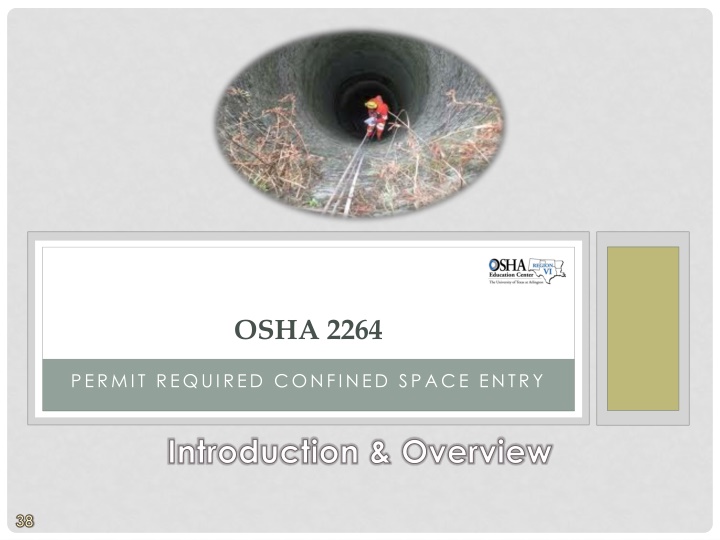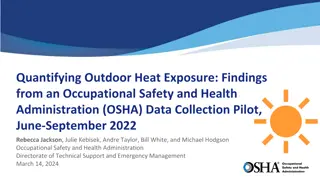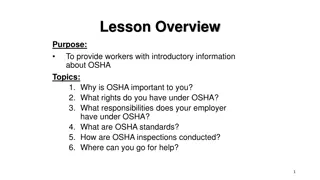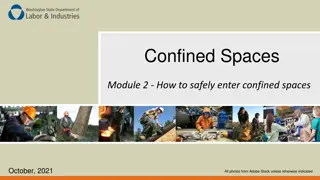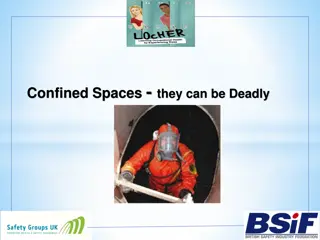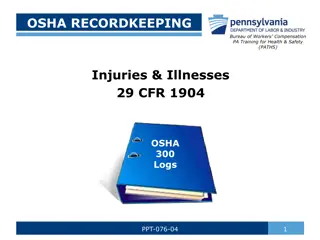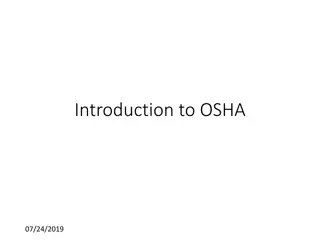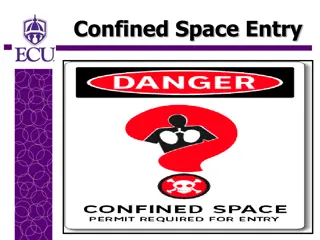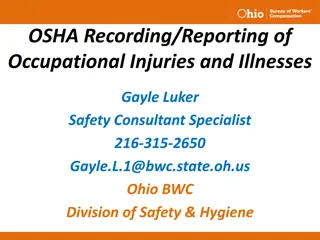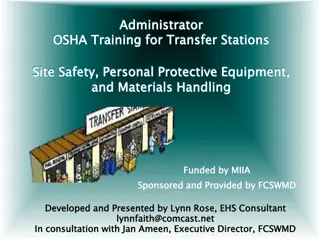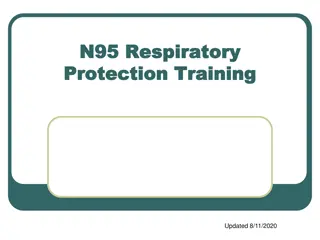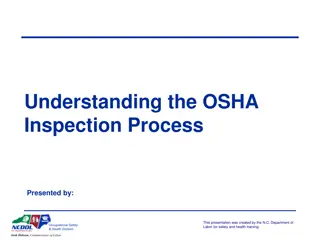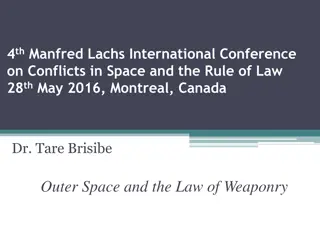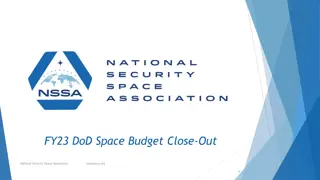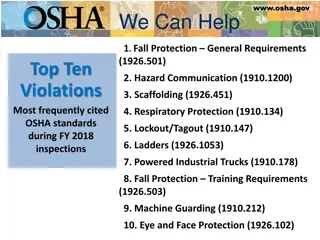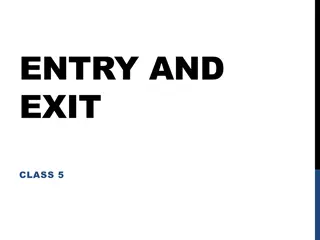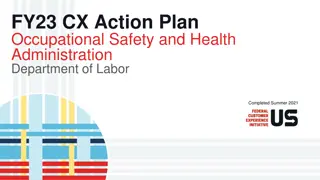OSHA Regulations for Confined Space Entry
OSHA regulations play a crucial role in ensuring the safety of workers entering confined spaces. Learn about the causes of fatalities, exempt industries, rescue operations, definitions, and more. Discover the importance of performance-oriented standards and employer responsibilities to create a safe working environment.
Download Presentation

Please find below an Image/Link to download the presentation.
The content on the website is provided AS IS for your information and personal use only. It may not be sold, licensed, or shared on other websites without obtaining consent from the author.If you encounter any issues during the download, it is possible that the publisher has removed the file from their server.
You are allowed to download the files provided on this website for personal or commercial use, subject to the condition that they are used lawfully. All files are the property of their respective owners.
The content on the website is provided AS IS for your information and personal use only. It may not be sold, licensed, or shared on other websites without obtaining consent from the author.
E N D
Presentation Transcript
OSHA 2264 PERMIT REQUIRED CONFINED SPACE ENTRY Introduction & Overview 38
OBJECTIVES 1. List the causes of fatalities in confined space operations 2. List industries exempted from permit-required confined space entry procedures 3. Describe other regulations and standards affecting confined space rescue operations 4. Define a confined space 5. Define a permit-required confined space 6. Describe examples of permit-required confined spaces 7. Introduce the actors in confined space activities April 8, 2025 Slide 2
INTRODUCTION Entry into confined spaces is a very dangerous endeavor. Several federal and state laws have been passed to provide for the safe entry AND EXIT of these very common industrial spaces. Our focus will be on the federal regulations for general industry applications found at 29 CFR 1910.146. April 8, 2025 Slide 3
INTRODUCTION This regulation does not cover groups covered by other regulations Shipyard employment (29 CFR 1915) Construction (29 CFR 1926) Agriculture (29 CFR 1928) April 8, 2025 Slide 4
INTRODUCTION Federal standard is performance oriented meaning that OSHA doesn t intend to specify exact methods of compliance. Instead, compliance is driven towards performance that Meets the requirements of the standard; and Prevents unsafe acts in confined spaces April 8, 2025 Slide 5
INTRODUCTION The employer is responsible for assuring that employees can function safely and training is not enough! The employer must also develop safe procedures that allow Safe entry; Effective performance of work; and Safe exit April 8, 2025 Slide 6
INTRODUCTION Obviously, performance standards cut both ways. (+) Employers have the ability to tailor safe confined space procedures to their needs. (-) Final decisions about compliance are often left to individual OSHA inspectors. April 8, 2025 Slide 7
SCOPE OF THE STANDARD Definitions Scope & Application Preparation for Confined Space Entry Atmospheric testing Attendants & rescue teams Permit systems Training Special equipment & tools Retrieval systems & respiratory protection April 8, 2025 Slide 8
OTHER APPLICABLE REGULATIONS Respiratory Protection Lock Out / Tag Out / Block Out Fall Protection Trench Excavation April 8, 2025 Slide 9
WHY HAVE A STANDARD ??? From 2005 2009, 481 fatalities were reported in occurred in confined spaces in occupational settings 96.2 fatalities annually 1.85 fatalities weekly 1 fatality every four (4) days Source: Roco Rescue RescueTalk blog 11/01/11 April 8, 2025 Slide 10
WHY HAVE A STANDARD??? Deaths spanned about every age group > 61% were in construction, repairing or cleaning (regular construction workers & management) Physical hazards: Struck by Caught in Collapses Falls Source: Roco Rescue RescueTalk blog 11/01/11 April 8, 2025 Slide 11
WHY HAVE A STANDARD??? Atmospheric hazards O2 issues Toxics Fires Physical hazards Struck by Caught in Collapses Falls Source: Roco Rescue RescueTalk blog 11/01/11 April 8, 2025 Slide 12
WHY HAVE A STANDARD??? For the most part, these deaths were PREVENTABLE events. Proper safety concerns & procedures when working in confined spaces are key. Remember planning favors the fortunate. April 8, 2025 Slide 13
CONFINED SPACES: Must meet all three (3) of the following criteria: 1. Space that is large enough for a person to enter and perform work; 2. Space that has a limited means of entry & exit; and 3. Space that is not designed for continuous human occupancy. April 8, 2025 Slide 14
EXAMPLES OF CONFINED SPACES Sewers Tunnels Tanks Wells Vaults & Cellars Pits & Sumps April 8, 2025 Slide 15
PERMIT REQUIRED CONFINED SPACES Confined spaces that contain additional special hazards. Permit-Required Confined Spaces require thoughtful, proactive planning and the development and issuance of permits prior to entry. skull skulls April 8, 2025 Slide 16
PERMIT REQUIRED CONFINED SPACES: Contain, or have the potential to contain, serious safety and/or health hazards which might preclude an entrant from escaping without death of physical harm. These hazards include, but are not limited to: Engulfment hazards Slippery surfaces Noise Toxic atmospheres Psychological issues (claustrophobia, isolation) Confusing configurations Falling objects Toxic or flammable atmospheres Exposure to excessive heat or cold Oxygen deficiency April 8, 2025 Slide 17
CONFINED SPACE ENTRY PERMIT Confined Space Entry Permit must include: Location of the space Description of the work Description of the hazards Description of the controls Time period of the permit Name of the attendant April 8, 2025 Slide 18
CONFINED SPACE ENTRY PERMIT Record of each entrant s entries & exits List of rescue equipment Verification that rescue equipment is in good working order Results of air monitoring & testing Communications Sign-off Hot Work provisions (if necessary) April 8, 2025 Slide 19
ENTRY INTO CONFINED SPACES: Occurs when any part of the entrant s body breaks the plane of entrance into the space. April 8, 2025 Slide 20
PERMIT REQUIRED CONFINED SPACES Hazards associated with fatalities in confined space entry can be broadly broken into two (2) categories: Failure to identify and manage the hazards in the space: Inadequate/incorrect emergency response techniques (rushing in spontaneously for rescue). April 8, 2025 Slide 21
PERMIT REQUIRED CONFINED SPACES Failure to identify and manage the hazards in the space: 1. Atmospheric hazards O2 deficiency & displacement Toxics Flammable 2. Physical hazards Engulfment Electrocution Reactivation injuries Release of materials and/or Falling objects. Slick / slippery surfaces. Temperature extremes April 8, 2025 Slide 22
HAZARDS PRESENT IN CONFINED SPACES Oxygen deficiency: Inadequate ventilation, consumption of O2 (process, bacterial activity & oxidation). Oxygen displacement: Simple asphyxiants (nitrogen & carbon dioxide) displace oxygen. Chemical asphyxiants (react with oxygen and use it up) Flammable/Combustible atmospheres: Vapor, gases and/or enriched oxygen. Toxic atmospheres: Residue Decomposition (H2S from sludge, CO from welding, chlorine from bleach). April 8, 2025 Slide 23
FLAMMABILITY HAZARDS The Fire Triangle / Fire Tetrahedron Ignition can occur from something as innocuous as a spark from static electricity or a tool accidentally banged against a piece of metal. April 8, 2025 Slide 24
TOXICITY HAZARDS SO2 NH3 NO CO H2S Cl HCN April 8, 2025 Slide 25
PHYSICAL HAZARDS Engulfment (becoming trapped or enveloped) Electrocution / Injury from reactivation (failure to apply LOTO). Release of materials into the confined space. Falling objects. Slick or slippery surfaces. Hot and Cold temperature extremes. April 8, 2025 Slide 26
PERMIT REQUIRED CONFINED SPACES Inadequate/incorrect emergency response techniques (rushing in spontaneously for rescue). Roughly 60% of fatalities related to confined space entry are would-be rescuers. April 8, 2025 Slide 27
THE ACTORS Entrants Attendants Supervisors April 8, 2025 Slide 28
CONFINED SPACE ENTRY JOB DUTIES ENTRANTS Know the hazards inside the space Use assigned PPE for the job at hand Maintain communication throughout entry. Recognize signs of over-exposure. Evacuate the space When the order is given When an unsafe condition / over-exposure occurs. April 8, 2025 Slide 29
CONFINED SPACE ENTRY JOB DUTIES ATTENDANTS Maintain position outside the space entrance AT ALL TIMES while entrants are inside. Recognize signs / symptoms of over-exposure. Prevent unauthorized access. Maintain communications with the entrants. Initiate emergency response when necessary. April 8, 2025 Slide 30
CAUTION!!! April 8, 2025 Slide 31
CONFINED SPACE ENTRY JOB DUTIES SUPERVISOR Conduct pre-entry evaluation and discussion. Ensure all entry personnel are aware of the hazards inside the space. Implement all control procedures including ventilation. Contact Safety & Emergency Personnel and ensure they are available if needed. Coordinate initial testing of the space and ensure appropriate safety precautions have been placed in effect prior to entry. Complete the Confined Space Entry Permit. April 8, 2025 Slide 32
EMERGENCIES An Emergency is anycondition like an Energy release Detection of a hazardous or toxic atmosphere A personnel issue Other hazard Upon recognition of an emergency or unsafe condition, entrants must be removed as soon as possible. April 8, 2025 Slide 33
EMERGENCIES Attendants will call 911 or onsite emergency personnel if an entrant is injured or indicates signs of over-exposure or oxygen deficiency. Use retrieval equipment to remove entrant personnel as necessary. April 8, 2025 Slide 34
QUESTIONS ??? April 8, 2025 Slide 35
ACTIVITY April 8, 2025 Slide 36
USING WHAT YOU HAVE LEARNED In your teams, take a short walk around the Fire Service Training Center Building, and identify (count) the Spaces Confined Spaces Permit-Required Confines Spaces Your walk should last no more than thirty (30) minutes, and include a short break. We ll talk about your findings when you return. April 8, 2025 Slide 37
QUESTIONS ??? April 8, 2025 Slide 38
